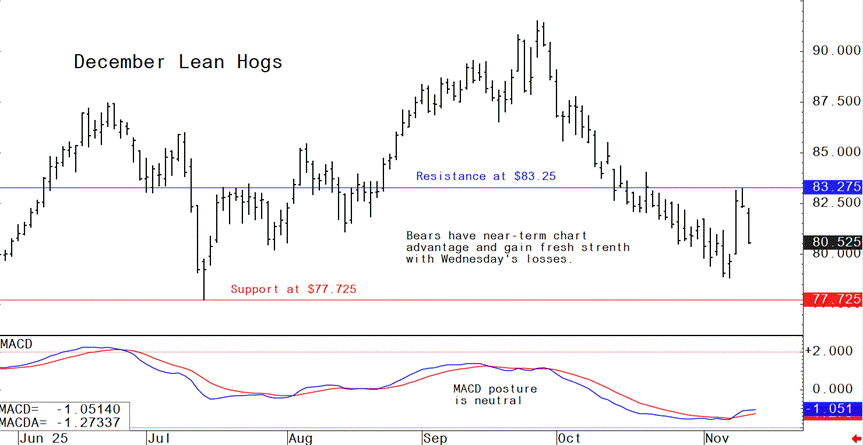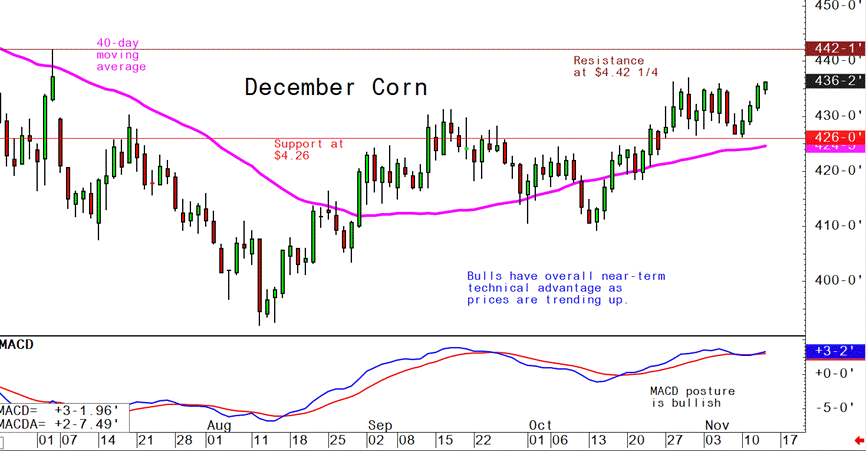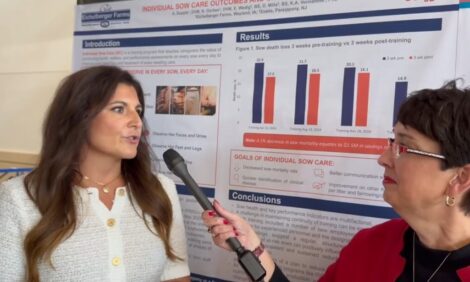



Pig outlook: Lean hog futures bears remain in control
Livestock analyst Jim Wyckoff reports on global pig news
Lean hog futures Wednesday saw a resumption of chart-based selling. A continued erosion in cash hog prices also emboldened the speculator bears in lean hog futures at mid-week. Lower live and feeder cattle futures prices Wednesday also spilled over into some selling in hog futures. The latest CME lean hog index is down another 24 cents at $89.17. Today’s projected cash hog index is down 4 cents at $89.13. Wednesday’s national direct 5-day rolling average cash hog price quote is $83.76.
Technical analysis: December lean hog futures bears have the overall near-term technical advantage. The next upside price objective for the hog bulls is to close December futures prices above solid chart resistance at $85.00. The next downside price objective for the bears is closing prices below solid technical support at last week’s low of $78.80. First resistance is seen at today’s high of $82.275 and then at this week’s high of $83.25. First support is seen at this week’s low of $80.00 and then at $78.80.
World food prices decline for second straight month, FAO reports
Sugar and meat drive October drop as global supplies strengthen; record cereal output projected for 2025
World food prices fell for a second consecutive month in October, according to the United Nations’ Food and Agriculture Organization (FAO), as ample global supplies eased pressure across key commodities.
The FAO Food Price Index averaged 126.4 points in October, down from a revised 128.5 in September, marking a slight year-over-year decline and standing 21.1% below its March 2022 peak.
Sugar led the downturn, with its sub-index falling 5.3% to the lowest level since December 2020, reflecting strong production in Brazil, higher output forecasts in Thailand and India, and weaker crude oil prices.
Dairy prices slid 3.4%, driven by lower milk powder and butter values amid strong export availability from the EU and New Zealand.
Meat prices also eased 2%, ending eight months of gains, as pork and poultry prices fell, though beef prices remained firm on continued global demand. In contrast, vegetable oils rose 0.9%, reaching their highest since July 2022.
In a separate update, the FAO projected record global cereal production of 2.99 billion metric tons for 2025, up 4.4% from 2024, with record highs expected for both corn and rice.
Jalisco Reports First Screwworm Case as Mexico Reaches 757 Active Outbreaks
Senasica confirms 85 new cases in one month; Chiapas, Veracruz, and Yucatán remain the most affected regions amid intensified U.S./Mexico eradication efforts
The Mexican state of Jalisco has confirmed its first case of screwworm, joining thirteen other states battling the livestock parasite, according to the National Service for Agrifood Health, Safety and Quality (Senasica). The case was detected in a feedlot in Encarnación de Díaz and promptly contained, officials said.
The Mexican state of Jalisco lies in western-central Mexico and is roughly 550–600 miles from the nearest point on the U.S. border (typically measured to Laredo, Texas, or Nogales, Arizona). Guadalajara, Jalisco’s capital, is about 600 miles (965 km) south of Laredo, Texas by road. It’s roughly 575 miles from Nogales, Arizona, and about 700 miles from El Paso, Texas. That distance places Jalisco well inland — several states north of Mexico City but still far from the U.S. border region.
As of Nov. 5, Mexico has 757 active outbreaks, up 85 from last month’s total of 672. The majority of cases are concentrated in Chiapas (264), Veracruz (165), and Yucatán (128), followed by Oaxaca (95), Tabasco (45), Campeche (29), Quintana Roo (29), and single cases in Guerrero and Jalisco.
Mexico’s Ministry of Agriculture and Rural Development (Sader) credited swift inspection protocols for containing Jalisco’s case, which was identified during the review of a shipment of 80 cattle from southeastern Mexico. Senasica emphasized that the finding is isolated and poses no threat to Jalisco’s livestock industry.
The confirmation coincides with a binational review of the U.S./Mexico screwworm eradication campaign, where Sader Secretary Julio Berdegué Sacristán and USDA Secretary Brooke Rollins assessed progress and reportedly planned actions to resume livestock exports.
By species, Senasica’s week-45 report lists 506 cases in cattle, 141 in dogs, 44 in pigs, 39 in horses, and 19 in sheep. Since the first outbreak in November 2024, Chiapas alone accounts for half of the 4,520 accumulated cases, followed by Oaxaca (1,119), Tabasco (980), Veracruz (960), and Yucatán (940).
Officials warn that the recent uptick highlights the need for continued surveillance in southeastern regions, where warm and humid conditions favor the pest’s persistence.
The next week’s likely high-low price trading ranges:
- December lean hog futures--$77.50 to $83.25 and with a sideways bias
- December soybean meal futures--$310.50 to $330.00, and with a sideways-higher bias
- December corn futures--$4.25 to $4.40 and a sideways-higher bias
Latest analytical daily charts lean hog, soybean meal and corn futures











